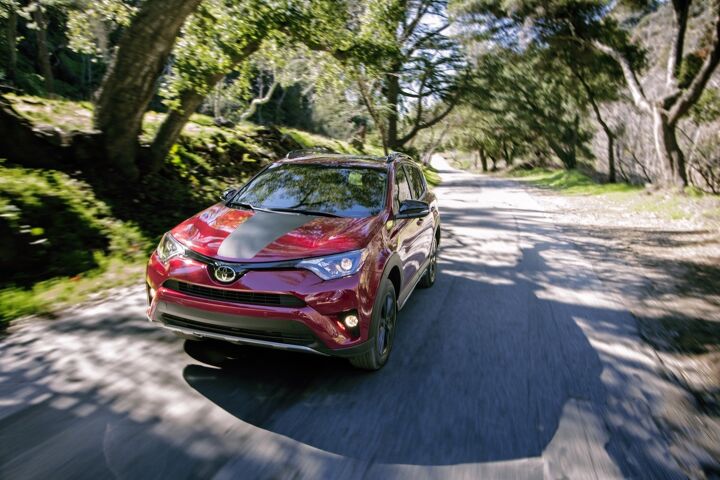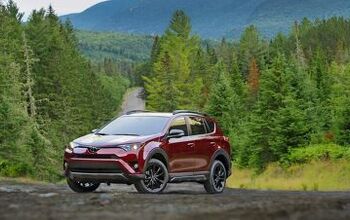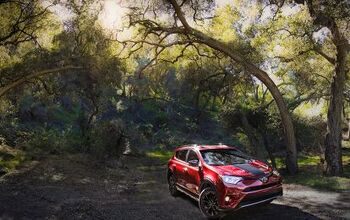The 2018 Toyota RAV4 Adventure Will Certainly Not Be the Most Expensive RAV4
The allegedly rugged and especially outdoorsy version of America’s best-selling utility vehicle will be priced below the top-of-the-range for its debut model year. The 2018 Toyota RAV4 Adventure starts at $28,695, according to CarsDirect, which places the higher, more tow-ready RAV4 above the SE but below the XLE in Toyota’s compact crossover lineup.
Toyota has already sold 269,835 copies of the RAV4 in the United States through the first eight months of 2017, easily a record start for the RAV4 that appears destined to fulfill Toyota’s forecasts by cresting the 400,000-sale marker by the end of the year. The RAV4 Adventure, Toyota predicts, will generate 40,000 annual sales, though it will surely be stealing some of those buyers from other parts of the RAV4 lineup.
The RAV4 Adventure does not, however, come standard with all-wheel drive. Yet unlike other RAV4 variants, where the cost of all-wheel drive ranges from $915-$1400, the RAV4 Adventure’s optional all-wheel drive will add just $700 to the MSRP, CarsDirect says.
Potential indirect competitors are thick on the ground, but in terms of likeminded vehicles, the Toyota RAV4 Adventure’s list of direct rivals is short. There’s no offroadified Nissan Rogue, Honda CR-V, Ford Escape, Chevrolet Equinox, Subaru Forester, or Mazda CX-5.
That leaves the Jeep Cherokee Trailhawk, which starts at $32,090. More ready for the Rubicon? Most definitely.
But while you may mock the RAV4 Adventure for its car foundation, you must admit that it is more — albeit only slightly more — prepared for a rough road. The 2018 Toyota RAV4 Adventure offers extra ground clearance: four-tenths of an inch more than other RAV4s. There are also skid plates, which might come in handy when you realize that the extra ground clearance only produces 6.5 inches in total. The 18-inch wheels wear 235/55R18 tires, the same size as other high-trim RAV4s. The RAV4 Adventure will also tow an extra 2,000 pounds, for 3,500 in total, and it’s equipped with a 120V outlet in the cargo area.
The RAV4 Adventure AWD’s $29,395 price will place it above the RAV4 XLE, which Toyota says is priced at $27,895 with AWD, but below the RAV4 SE, which is priced at $31,185 with AWD. Further up the ladder, you’ll also find RAV4s Limited and Platinum, priced at $33,300 and $37,145 when fitted with four driven wheels. There’s also a hybrid lineup, featuring standard all-wheel drive, with prices ranging from $28,905-$35,025. All prices include $995 for destination fees.
Through the first two-thirds of 2017, the RAV4 that now tops Toyota’s sales charts is also nearly 12,000 sales ahead of America’s second-best-selling utility vehicle, the Nissan Rogue. Of course, that’s an unfair comparison, because Nissan is linking two vehicles, the Rogue and Rogue Sport, in one model family. The leader of the pack in each of the five previous years is also gaining momentum, rising 8 percent toward its own record sales pace this year, but the Honda CR-V is nevertheless nearly 20,000 sales behind the leader.
If Toyota conducts the final four months of the year at the same rate of growth achieved with the RAV4 to date, 2017 will end with a top-selling SUV/crossover generating more than 400,000 sales. That hasn’t happened since 2002, when the Ford Explorer produced 433,847 U.S. sales.
[Image: Toyota]
Timothy Cain is a contributing analyst at The Truth About Cars and Autofocus.ca and the founder and former editor of GoodCarBadCar.net. Follow on Twitter @timcaincars and Instagram.
More by Timothy Cain
Latest Car Reviews
Read moreLatest Product Reviews
Read moreRecent Comments
- MaintenanceCosts Nobody here seems to acknowledge that there are multiple use cases for cars.Some people spend all their time driving all over the country and need every mile and minute of time savings. ICE cars are better for them right now.Some people only drive locally and fly when they travel. For them, there's probably a range number that works, and they don't really need more. For the uses for which we use our EV, that would be around 150 miles. The other thing about a low range requirement is it can make 120V charging viable. If you don't drive more than an average of about 40 miles/day, you can probably get enough electrons through a wall outlet. We spent over two years charging our Bolt only through 120V, while our house was getting rebuilt, and never had an issue.Those are extremes. There are all sorts of use cases in between, which probably represent the majority of drivers. For some users, what's needed is more range. But I think for most users, what's needed is better charging. Retrofit apartment garages like Tim's with 240V outlets at every spot. Install more L3 chargers in supermarket parking lots and alongside gas stations. Make chargers that work like Tesla Superchargers as ubiquitous as gas stations, and EV charging will not be an issue for most users.
- MaintenanceCosts I don't have an opinion on whether any one plant unionizing is the right answer, but the employees sure need to have the right to organize. Unions or the credible threat of unionization are the only thing, history has proven, that can keep employers honest. Without it, we've seen over and over, the employers have complete power over the workers and feel free to exploit the workers however they see fit. (And don't tell me "oh, the workers can just leave" - in an oligopolistic industry, working conditions quickly converge, and there's not another employer right around the corner.)
- Kjhkjlhkjhkljh kljhjkhjklhkjh [h3]Wake me up when it is a 1989 635Csi with a M88/3[/h3]
- BrandX "I can charge using the 240V outlets, sure, but it’s slow."No it's not. That's what all home chargers use - 240V.
- Jalop1991 does the odometer represent itself in an analog fashion? Will the numbers roll slowly and stop wherever, or do they just blink to the next number like any old boring modern car?
































Comments
Join the conversation
So $35,000 for one of the best Chevy impalas ever is unreasonable, but $35,000 for this raises no objections......
My question is how can they suddenly add 2000 lbs of towing capacity by lifting it a hair? Does it have a transmission cooler as well? Upgraded brakes?